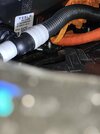Hi Guys,
Question: iI have been doing some calculations lately based on the % used and the Kwh consumed lately. All of the tests I did lead to the conclusion my 2019 M3P @ 48000km has about 65kwh usable capacity (left).
Yesterday, I charged to 100% (for the test), drove to relatives, stayed there couple of hours (no sentry! / app usage) and drove back. According to the screen i used 27 kwh in 42% which leads to -> 27÷ 0,42 -> 64.28 kwh capacity at 100% (of the 72 net it should have). Off course i could have had some drain while standing still, but not much.
Range @ 100% is 438km of the original 500.
I haven't supercharged much (about 7000-8000km of the 48000) and mostly charge to 80%. I make sure I never leave it at low or high SoC.
Stats from TeslaFi (I haven't had an account for all the Km's):
View attachment 735989
I find this quite disappointing, or am I missing something?
and the degradation report wouldnt look like this:




